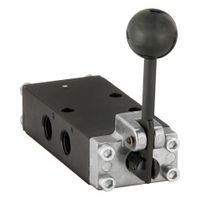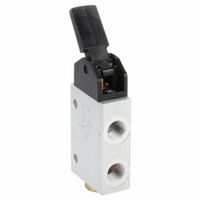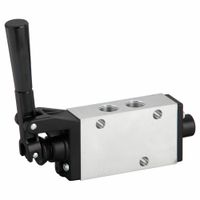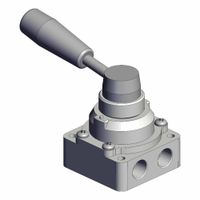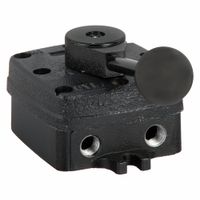Call +(254) 703 030 000 / 751 483 999 / 721 704 777
- Home
- Pneumatics
- Pneumatic Valves
- Inline Air Control Valves
- Manually Activated Inline Air Control Valves
.....Read More
Frequently Asked Questions
What are manually-activated inline air control valves?
Manually-activated inline air control valves are mechanical devices used to regulate the flow of air within a pneumatic system. These valves are operated by hand, allowing users to start, stop, or modulate the air flow as needed. They are typically installed directly in the air line, hence the term "inline."
These valves come in various types, including ball valves, gate valves, and needle valves, each offering different levels of control and precision. Ball valves, for instance, provide quick on/off control with a simple 90-degree turn of the handle. Gate valves are used for more gradual control, while needle valves offer precise flow regulation.
The construction of these valves usually involves durable materials like brass, stainless steel, or plastic, chosen based on the application's pressure, temperature, and environmental conditions. The choice of material affects the valve's durability, resistance to corrosion, and suitability for specific applications.
Manually-activated inline air control valves are commonly used in industrial settings, such as manufacturing plants, automotive workshops, and HVAC systems, where precise control of air flow is crucial. They are also found in laboratory environments and various machinery that rely on pneumatic systems.
These valves are valued for their simplicity, reliability, and ease of maintenance. Since they do not require electrical or pneumatic actuation, they are ideal for applications where power sources are limited or where simplicity is preferred. However, their manual operation means they are best suited for applications where frequent adjustments are not necessary, as they require human intervention to change the flow settings.
How do manually-activated inline air control valves work?
Manually-activated inline air control valves regulate airflow in pneumatic systems. They consist of a valve body, an actuator, and a control mechanism. The valve body houses the internal components, including the valve seat and the sealing element, which can be a disc, ball, or diaphragm. The actuator is typically a lever, knob, or handwheel that the user manipulates to control the valve's position.
When the actuator is turned or moved, it adjusts the position of the sealing element relative to the valve seat. This action either opens or closes the valve, allowing for precise control of airflow. In the open position, air flows through the valve, while in the closed position, airflow is stopped. Intermediate positions allow for partial flow, enabling fine-tuning of air pressure and volume.
The control mechanism often includes a stem or spindle connected to the actuator, which translates the manual input into linear or rotary motion. This motion moves the sealing element, altering the flow path. Some valves may have a locking feature to maintain a set position, preventing accidental adjustments.
These valves are used in various applications, such as controlling air supply to pneumatic tools, adjusting airflow in HVAC systems, or regulating pressure in industrial processes. They are valued for their simplicity, reliability, and ease of maintenance. Proper selection and installation ensure optimal performance and longevity, with materials chosen based on the specific requirements of the application, such as pressure, temperature, and compatibility with the air medium.
What brands offer manually-activated inline air control valves?
Brands that offer manually-activated inline air control valves include:
1. **Parker Hannifin** - Known for a wide range of motion and control technologies, Parker offers various manually-operated air control valves suitable for different industrial applications.
2. **SMC Corporation** - A leading manufacturer of pneumatic components, SMC provides a variety of manual air control valves designed for precision and reliability.
3. **Festo** - Specializing in automation technology, Festo offers manually-operated air control valves that are used in various industrial settings for controlling air flow.
4. **Norgren (part of IMI Precision Engineering)** - Norgren provides a comprehensive range of manually-operated air control valves, known for their durability and efficiency in controlling pneumatic systems.
5. **Clippard** - Clippard offers a selection of manually-operated air control valves, including toggle and push-button types, suitable for various pneumatic applications.
6. **Aventics (part of Emerson Electric Co.)** - Aventics provides a range of manual air control valves that are used in different industrial applications, known for their precision and reliability.
7. **Bimba (part of IMI Precision Engineering)** - Bimba offers a variety of manually-operated air control valves, designed for easy integration into pneumatic systems.
8. **Humphrey Products** - Specializing in pneumatic and fluid control products, Humphrey offers manually-operated air control valves that are used in a wide range of applications.
9. **ASCO (part of Emerson Electric Co.)** - ASCO provides a range of manually-operated air control valves, known for their robust design and reliability in industrial applications.
10. **Legris (part of Parker Hannifin)** - Legris offers a selection of manually-operated air control valves, known for their ease of use and integration into pneumatic systems.
How do I choose the right manually-activated inline air control valve for my system?
1. **System Requirements**: Determine the pressure, temperature, and flow rate requirements of your system. Ensure the valve can handle these specifications.
2. **Valve Type**: Choose between different types such as ball, gate, globe, or butterfly valves based on the application. Ball valves are good for quick shut-off, while globe valves are better for flow regulation.
3. **Material Compatibility**: Select a valve made from materials compatible with the media (e.g., water, gas, chemicals) to prevent corrosion or degradation. Common materials include brass, stainless steel, and PVC.
4. **Size and Connection**: Ensure the valve size matches the pipe diameter and check the type of connection (threaded, flanged, or welded) for compatibility with your system.
5. **Operation and Accessibility**: Consider the ease of manual operation and the location of the valve. Ensure it is accessible for maintenance and operation.
6. **Pressure Rating**: Verify the valve’s pressure rating to ensure it can withstand the maximum pressure of your system.
7. **Temperature Rating**: Check the valve’s temperature rating to ensure it can operate effectively under your system’s temperature conditions.
8. **Flow Characteristics**: Consider the flow characteristics (linear, equal percentage, or quick opening) that best suit your application.
9. **Durability and Maintenance**: Choose a valve known for durability and ease of maintenance to reduce downtime and costs.
10. **Cost and Availability**: Balance cost with quality and availability. Ensure the valve is within budget and readily available for purchase and replacement.
11. **Compliance and Standards**: Ensure the valve meets industry standards and regulations for safety and performance.
12. **Supplier Reputation**: Purchase from reputable suppliers known for quality products and good customer support.
What are the benefits of using manually-activated inline air control valves?
Manually-activated inline air control valves offer several benefits:
1. **Precision Control**: They allow for precise regulation of airflow, enabling users to adjust the flow rate according to specific requirements, which is crucial in applications needing exact air pressure or volume.
2. **Cost-Effectiveness**: These valves are generally less expensive than automated systems, making them a cost-effective solution for smaller operations or where budget constraints exist.
3. **Simplicity and Reliability**: With fewer components than automated systems, manually-activated valves are simpler to operate and maintain. This simplicity often translates to increased reliability and a longer lifespan.
4. **No Power Requirement**: They do not require electricity or batteries, making them ideal for remote locations or situations where power supply is unreliable or unavailable.
5. **Immediate Feedback and Adjustment**: Operators can receive immediate tactile feedback and make real-time adjustments, which is beneficial in dynamic environments where conditions change rapidly.
6. **Durability**: Typically constructed from robust materials, these valves can withstand harsh conditions, including extreme temperatures and pressures, making them suitable for industrial applications.
7. **Versatility**: They can be used in a wide range of applications, from industrial machinery to HVAC systems, due to their ability to handle various types of gases and pressures.
8. **Safety**: Manual operation allows for quick shut-off in emergencies, providing an added layer of safety in critical situations.
9. **User Control**: They empower users with direct control over the system, which can be advantageous in training environments or where human oversight is preferred.
10. **Minimal Maintenance**: With fewer moving parts, these valves require less maintenance, reducing downtime and operational costs.
Overall, manually-activated inline air control valves are a practical choice for applications where simplicity, reliability, and cost are prioritized.
How do I install a manually-activated inline air control valve?
1. **Select the Valve**: Choose a manually-activated inline air control valve suitable for your system's pressure and flow requirements.
2. **Gather Tools and Materials**: You will need the valve, appropriate fittings, Teflon tape or pipe sealant, a pipe cutter or wrench, and possibly a mounting bracket.
3. **Turn Off Air Supply**: Ensure the air supply is completely shut off and the system is depressurized to prevent accidents.
4. **Identify Installation Location**: Determine the best location for the valve, ensuring it is accessible for manual operation and maintenance.
5. **Cut the Pipe**: Use a pipe cutter or wrench to cut the air line where the valve will be installed. Ensure the cut is clean and straight.
6. **Prepare Pipe Ends**: Clean the pipe ends and remove any burrs. Apply Teflon tape or pipe sealant to the threads of the pipe ends to ensure a tight seal.
7. **Install the Valve**: Attach the valve to the pipe ends. If the valve has threaded connections, screw it onto the pipe ends by hand, then tighten with a wrench. Ensure the valve is oriented correctly according to the flow direction indicated on the valve body.
8. **Secure the Valve**: If necessary, use a mounting bracket to secure the valve to a stable surface to prevent movement and stress on the piping.
9. **Check for Leaks**: Slowly turn the air supply back on and check for leaks around the valve connections. Tighten connections if necessary.
10. **Test the Valve**: Manually operate the valve to ensure it opens and closes smoothly and controls the air flow as intended.
11. **Final Inspection**: Conduct a final inspection to ensure all connections are secure and the valve operates correctly.
What maintenance is required for manually-activated inline air control valves?
Maintenance for manually-activated inline air control valves includes:
1. **Regular Inspection**: Check for any visible signs of wear, corrosion, or damage. Ensure the valve body, handle, and connections are intact.
2. **Cleaning**: Remove any dust, dirt, or debris from the valve exterior. Clean the internal components if accessible, ensuring no contaminants affect operation.
3. **Lubrication**: Apply appropriate lubricant to the moving parts, such as the stem and handle, to ensure smooth operation. Use a lubricant compatible with the valve material and the air system.
4. **Seal and Gasket Check**: Inspect seals and gaskets for wear or damage. Replace them if they show signs of deterioration to prevent leaks.
5. **Leak Testing**: Perform regular leak tests by applying soapy water to joints and connections. Look for bubbles indicating air leaks and tighten or replace components as necessary.
6. **Operational Testing**: Manually operate the valve to ensure it opens and closes smoothly without excessive force. Check for any unusual noises or resistance.
7. **Calibration**: If the valve has any adjustable settings, ensure they are calibrated correctly according to system requirements.
8. **Documentation**: Keep records of maintenance activities, including inspections, repairs, and replacements, to track the valve's condition over time.
9. **Training**: Ensure personnel are trained in proper valve operation and maintenance procedures to prevent misuse and extend valve life.
10. **Replacement**: Replace the valve if it shows signs of irreparable damage or if it fails to function correctly despite maintenance efforts.
Regular maintenance ensures the valve operates efficiently, prevents system downtime, and extends the valve's lifespan.
